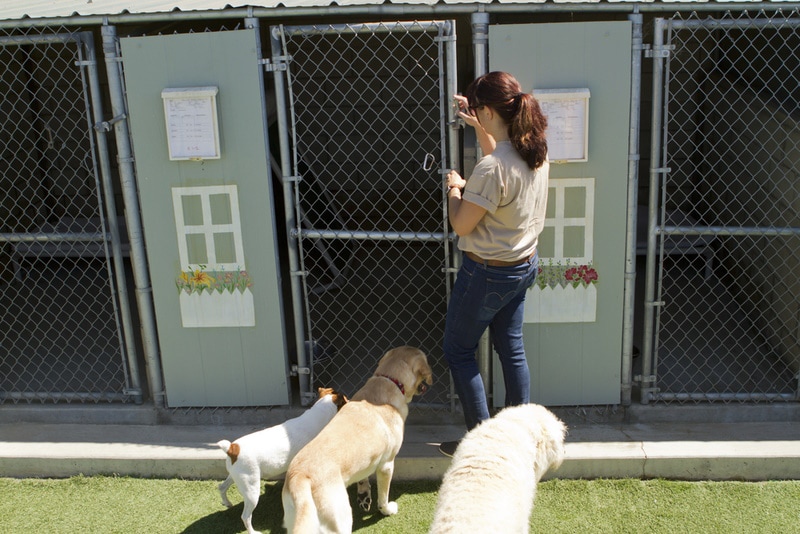How to Start a Dog Boarding Business: 8 Expert Tips

Updated on

Click to Skip Ahead
Starting a dog boarding business can be a gratifying endeavor if you’re passionate about dogs and have a knack for entrepreneurship. Given the growing number of pet parents who need care for their furry friends during vacations or workdays, starting a dog boarding business can be both fulfilling and profitable.
The 8 Tips on How to Start a Dog Boarding Business
1. Conduct Thorough Market Research
Before starting a dog boarding business, it’s crucial to understand the market and its dynamics. This involves identifying potential competitors, understanding their pricing and service structures, as well as the potential demand for dog boarding in your area.
Explore online platforms, visit local businesses, and conduct surveys to gather valuable information. Market research is the foundation upon which you can base your business decisions.

2. Create a Comprehensive Business Plan
A well-structured business plan can steer your business in the right direction. Your plan should include:
- An overview of your business
- A detailed description of your services
- Pricing strategies
- Marketing and sales strategies
- Financial projections
You should also outline your business objectives, strategies to achieve these goals, potential roadblocks, and mitigation plans.
3. Secure Necessary Funding
The initial setup of a dog boarding business can be capital-intensive, taking into account the cost of premises, pet supplies, insurance, licensing, and staff salaries. Thus, it’s crucial to have a clear understanding of your financial requirements.
You may seek funding through savings, bank loans, crowdfunding, or investors. Detailed financial planning ensures a smooth launch and sustainable operations.

4. Choose a Suitable Location
Location is key in a dog boarding business. The premises should be spacious, secure, and in a location easily accessible to your target market. Ideally, the location should be quiet and have outdoor space for the dogs to play and exercise.
Also, make sure that the site complies with zoning regulations for businesses of this nature. An optimal location greatly contributes to the success of your business.
5. Ensure Legal and Regulatory Compliance
Complying with local and national laws regarding animal care and business operations is critical. This includes obtaining necessary permits, licenses, and insurance.
Depending on your location, you may also need to comply with specific regulations concerning the care and boarding of pets. Partnering with a legal advisor can help ensure you adhere to all the requisite guidelines and avoid potential legal issues.

6. Invest in Staff and Training
Hire staff who share your passion for dogs and provide adequate training to ensure they are well-equipped to handle different breeds, temperaments, and situations. Staff training should cover basic dog care, first aid, emergency response, as well as customer service. A competent and caring staff is the backbone of a successful dog boarding business.
7. Market Your Business Effectively
Effective marketing can significantly enhance your business visibility. Start by creating a compelling website that showcases your services, pricing, location, and other pertinent information.
Utilize social media platforms to engage with potential clients. You can also consider partnerships with local pet stores, vets, and dog trainers to reach a wider audience. Remember, word-of-mouth referrals from satisfied customers can be incredibly beneficial.

8. Offer Exceptional Customer Service
Lastly, prioritize providing exceptional customer service. This includes offering personalized care for the dogs, maintaining transparent communication with pet parents, and handling any issues promptly and professionally.
Happy clients often result in repeat business and referrals, making customer service a cornerstone of your business’s success.
What’s Next? Tips for Running a Successful Boarding Business
After setting up your dog boarding business, the next challenge is running it successfully. This phase requires as much planning, dedication, and strategy as the startup phase. Here are some tips to help you run your new business effectively:
Offer Competitive Rates and Deals
Pricing your services competitively while maintaining profitability can be a delicate balance. It’s important to offer value to your clients while ensuring your business remains financially viable. Additionally, offering deals such as discounted rates for extended stays, package deals, or loyalty rewards can attract new customers and encourage repeat business.
Maintain High Standards of Hygiene and Safety
High hygiene and safety standards are paramount in a dog boarding business. Regular cleaning and disinfecting, timely waste management, and routine inspections for potential hazards should be part of your daily operations.
This not only ensures the health and safety of the dogs but also builds trust with your clients. Allowing your facility to fall into disrepair can quickly lead to lost sales. So make every effort to maintain your business to the highest standard.

Offer Additional Services
Adding value-added services like grooming, training, or doggie daycare can differentiate your business from competitors. These services can also provide additional revenue streams. Ensure your staff is adequately trained for these services and they meet the same high standard as your boarding services.
Continuously Evaluate and Improve Your Services
Continual evaluation and improvement of your services are vital to stay ahead in the market. Feedback from customers and staff can provide valuable insights into areas of improvement. You can also consider conducting occasional surveys or creating a feedback system to keep a pulse on your customers’ needs and satisfaction.
Build Strong Relationships with Clients
Building strong relationships with your clients can significantly impact the success of your business. Regular updates to pet parents during their dog’s stay, thank-you notes, and timely responses to queries or issues can foster trust and loyalty. Remember, a happy customer is a repeat customer and potentially a source of referrals.

Keep Up with Industry Trends
Stay updated with the latest trends in pet care and boarding. This might involve adopting new technologies, adjusting your services based on popular trends, or modifying your marketing strategy. Staying current ensures your business remains relevant and competitive.
Focus on Staff Retention
Staff turnover can disrupt your business operations and impact customer experience. Foster a positive work environment, offer competitive compensation, and provide opportunities for growth and development to retain your best employees.
Running a successful dog boarding business involves many moving parts, but with the right strategies in place, you can ensure a smooth operation. Following these tips can help you maintain a prosperous, growing business that both you and your furry clients will love.
Conclusion
Starting a dog boarding business is a significant undertaking, but with proper planning, passion, and dedication, it can prove to be a rewarding venture. The tips highlighted here today provide a roadmap to navigate the journey, ensuring you build a successful, sustainable business while providing invaluable service to pet parents and their furry companions.
Featured Image Credit: Jayme Burrows, Shutterstock












